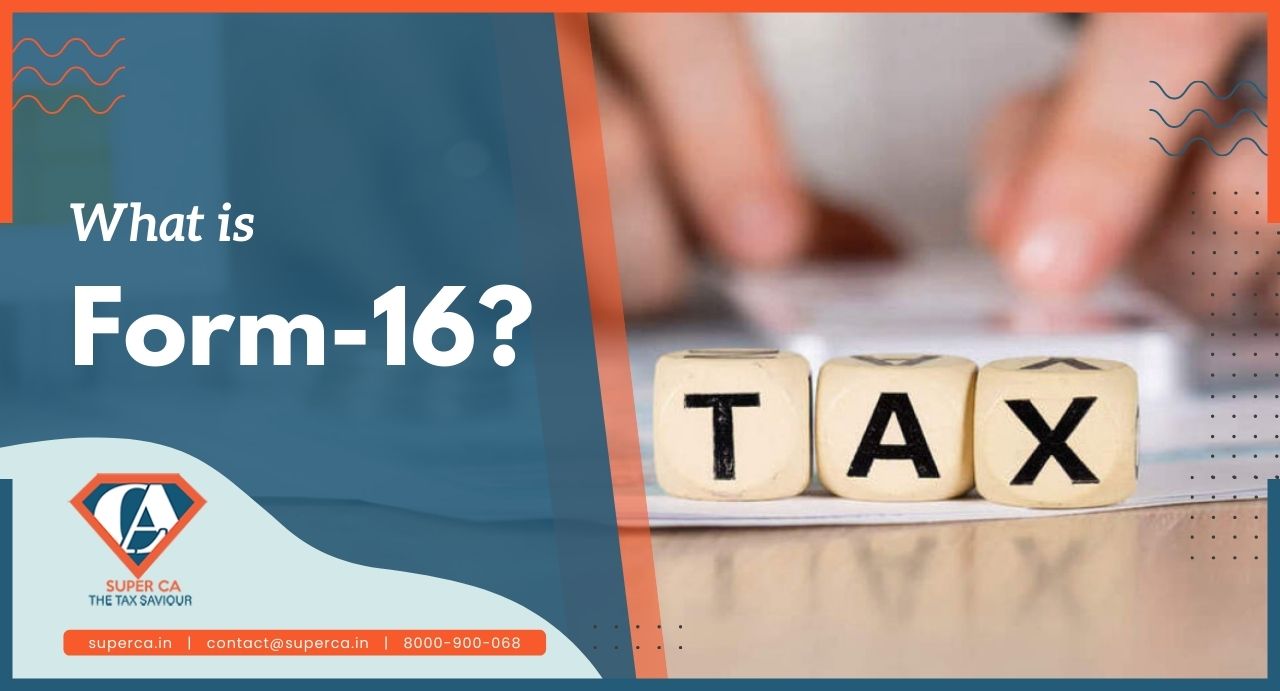What is Form 16 and How to File Your Income Tax Return Online?
- Posted By SuperCA
- On 30 September

About Form 16
As per the income tax laws, the return must be filed every year by an individual or business that earns any income during a financial year. The income could be in the form of a salary, business profits, income from house property or earned through dividends, capital gains, interests or other sources.
Income Tax Return (ITR) is a form that an individual is required to submit to the Income Tax Department of India. It is an explicit way of declaring one’s Total Income. This declaration should be made at the end of each Financial Year. It contains information about the person’s income and the taxes to be paid on it during that particular year. ITR filing is mandatory for all those who have income above the basic exemption limit under the Income Tax Act, 1961.
Key documents required
It is important to have all the relevant documents handy before you start your e-filing process.
- ➢ Aadhar & PAN Details.
- ➢ Form-16- TDS certificate issued to you by your employer to provide details of the salary paid to you and TDS deducted on it, if any
- ➢ Form-16A, if TDS is deducted on payments other than salaries such as interest received from fixed deposits, recurring deposits, etc. over the specified limits as per the current tax laws.
- ➢ Form-16B from the buyer if you have sold a property, showing the TDS deducted on the amount paid to you
- ➢ Form-16C from your tenant, for providing the details of TDS deducted on the rent received by you, if any
- ➢ Form 26AS - your consolidated annual tax statement. It has all the information about the taxes deposited against your PAN
Documents supporting -
- ➢ TDS deducted by your employer
- ➢ TDS deducted by banks
- ➢ TDS deducted by any other organizations from payments made to you
- ➢ Advance taxes deposited by you
- ➢ Self-assessment taxes paid by you
- ➢ Investment and Loan statements
- ➢ Income Details and Bank statement
- ➢ Advance tax receipt
- ➢ Documents related to interest income
- ➢ Proofs to claim deductions under sections 80D to 80U (health insurance premium for self and family, interest on education loan)
- ➢ Proofs of tax-saving investment
Form 16
Form 16 is the TDS certificate issued by the employer when they deduct TDS. It contains the information needed to prepare and file your income tax return. It shows the breakup of salary income and the TDS amount deducted by the employer. It has two prominent components – Part A and Part B. Part A gives a summary of the tax collected by the employer or organization from the salary of the employee and deposited with the Income Tax Department whereas Part B is an Annexure to Part A which is to be prepared by the employer for its employees and contains details of the breakup of salary and deductions approved under Chapter VI-A.
Importance of Form 16
Form 16 helps in the income tax returns e filing process and can be a crucial document as it works as proof that your employer has deducted tax from your salary and deposited it with the government. Further, it is usually requested by banks and financial institutions when you approach them for loans
According to the regulations issued by the Finance Ministry of the Indian Government, every salaried individual whose income falls under the taxable bracket is eligible for Form 16. You can get your Form 16 from your employer. Even if you have left your job, your employer will provide you with Form 16. Unfortunately, this income tax Form 16 cannot be downloaded from anywhere.
Process of filing Income Tax
Step 1: Collect required documents such as TDS certificates (Form16/16A), capital gains statement etc
Step 2: Download and check Form 26AS and rectify the errors.
Step 3: Computer total income of the FY.
Step 4: Compute tax liability and final payable tax.
Step 5: After filing, verify using electronic methods or physical verification.
How to get a copy of filed Income Tax Return
Step 1: Log in to the ‘e-Filing’ Portal
Step 2: Go to the ‘My Account menu
Step 3: Click ‘View e-Filed Returns / Forms’ hyperlink.
Step 4: Select the applicable option from the dropdown
Step 5: Click 'Submit' to view the details of the e-Filed Return/Forms.
Types of Income Tax Return Form
The Income Tax Department has prescribed 7 types of ITR forms - ITR-1, ITR-2, ITR-3, ITR-4, ITR-5, ITR-6, and ITR-7 and the applicability of the form will depend on the nature and amount of income and the type of taxpayer.
|
ITR Form |
Description |
|
ITR 1 (Sahaj) |
For Resident individuals who have income up to Rs 50 Lakh from ➣ Salary ➣ One house property ➣ Other sources (eg. Interest) |
|
ITR 2 |
For Individuals and HUFs having ➣ Income from ITR 1> 50 Lakhs ➣ Not carrying out business or profession under any proprietary ➣ Having more than one house ➣ Income from capital gains ➣ Having foreign income/foreign gains ➣ Holding directorship in a company or unlisted equity shares. |
|
ITR 3 |
For individuals and HUFs ➣ Income from ITR 2 ➣ Having income from business and profession. ➣ Presumptive Income in excess of Rs 50 Lakh |
|
ITR 4 (Sugam) |
➣Individuals opted for presumptive income scheme u/s 44AD/44DA/44AE ➣Having total income from business or profession up to Rs 50 Lakhs |
|
ITR 5 |
Not for Individuals, Companies, HUFs who file ITR 7 For Limited Liability Partnerships (LLPs), Association of persons (AOPs), Body of Individuals (BOIs), Trust and people under IT Act. |
|
ITR 6 |
For companies other than those claiming exemption u/s 11 on charitable or religious purposes. |
|
ITR 7 |
People and companies are required to furnish returns under ➣ Section 139 (4A) ➣ Section 139 (4B) ➣ Section 139 (4C) ➣ Section 139 (4D) |
Things to take care of before filing ITR
➢ Choose the correct ITR form.
➢ Furnish personal details properly
➢ Declare income in full and in an accurate way.
➢ File ITR on time to avoid unnecessary penalties.
➢ File important accompanied forms while claiming certain deductions.
➢ Interest from bank deposits or NSC certificates should be disclosed.
➢ Calculate tax liability accurately
➢ Do check & Verify Form 26AS for any mismatch.
Conclusion
Filing ITR timely is the responsibility of every person. It is a way to inform the Internal Revenue Service or State Tax Authority about one’s income, profit, losses or deductions from one’s business. It is compulsory to file income tax returns if your income is more than the basic exemption limit. The income tax rate is pre-decided for taxpayers. Any delay in filing returns will not only attract late filing fees but also hamper your chances of getting a loan or a visa for travel purposes.
We at SuperCA acknowledge that ITR filing is not a ‘file it forget it’ service. Hence, we are always there with you in every step during the course of action including preparation, filing, assessment, scrutiny, rectification, or refund.
Every income tax return filed is checked for accuracy and completeness. Everything that the clients enter goes through a robust check by our income tax experts. We are a Tax Savior. Our systems are designed to suggest deductions and tax exemptions applicable to income tax returns and also ensure that the clients get the maximum possible tax refund and they do not pay more than they owe.





